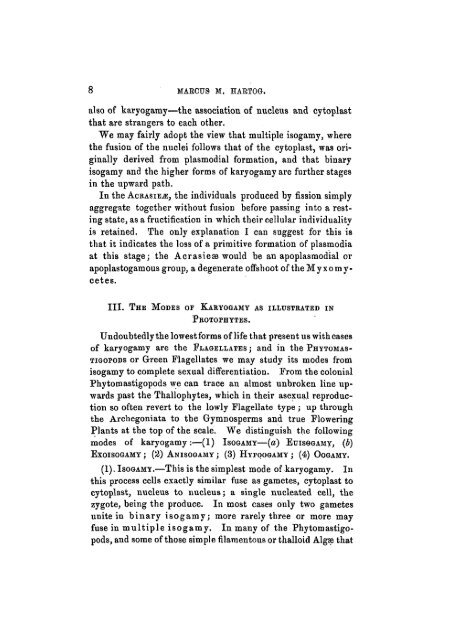Some Problems of Reproduction: a Comparative Study of ...
Some Problems of Reproduction: a Comparative Study of ...
Some Problems of Reproduction: a Comparative Study of ...
Create successful ePaper yourself
Turn your PDF publications into a flip-book with our unique Google optimized e-Paper software.
8 MARCUS M. HARTOG.<br />
also <strong>of</strong> karyogamy—the association <strong>of</strong> nucleus and cytoplast<br />
that are strangers to each other.<br />
"We may fairly adopt the view that multiple isogamy, where<br />
the fusion <strong>of</strong> the nuclei follows that <strong>of</strong> the cytoplast, was originally<br />
derived from plasmodial formation, and that binary<br />
isogamy and the higher forms <strong>of</strong> karyogamy are further stages<br />
in the upward path.<br />
In the AcRASiEiEj the individuals produced by fission simply<br />
aggregate together without fusioD before passing into a resting<br />
state, as a fructification in which their cellular individuality<br />
is retained. The only explanation I can suggest for this is<br />
that it indicates the loss <strong>of</strong> a primitive formation <strong>of</strong> plasmodia<br />
at this stage; the Acrasieas would be an apoplasmodial or<br />
apoplastogamous group, a degenerate <strong>of</strong>fshoot <strong>of</strong> the M y x o m ycetes.<br />
III. THE MODES OF KARYOGAMY AS ILLUSTRATED IN<br />
PROTOPHYTES.<br />
Undoubtedly the lowest forms <strong>of</strong> life that present us with cases<br />
<strong>of</strong> karyogamy are the FLAGELLATES ; and in the PHYTOMAS-<br />
TIGOPODS or Green Flagellates we may study its modes from<br />
isogamy to complete sexual differentiation. From the colonial<br />
Phytomastigopods we can trace an almost unbroken line upwards<br />
past the Thallophytes, which in their asexual reproduction<br />
so <strong>of</strong>ten revert to the lowly Flagellate type ; up through<br />
the Archegoniata to the Gymnosperms and true Flowering<br />
Plants at the top <strong>of</strong> the scale. We distinguish the following<br />
modes <strong>of</strong> karyogamy :—(1) ISOGAMY—(a) EUISSGAMY, (b)<br />
EXOISOGAMY ; (2) ANISOGAMY ; (3) HYPOOGAMY ; (4) OOGAMY.<br />
(1). ISOGAMY.—This is the simplest mode <strong>of</strong> karyogamy. In<br />
this process cells exactly similar fuse as gametes, cytoplast to<br />
cytoplast, nucleus to nucleus; a single nucleated cell, the<br />
zygote, being the produce. In most cases only two gametes<br />
unite in binary isogamy; more rarely three or more may<br />
fuse in multiple isogamy. In many <strong>of</strong> the Phytomastigopods,<br />
and some <strong>of</strong> those simple filamentous or thalloid Algse that

















